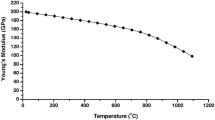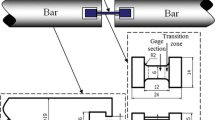Abstract
As an experimental technique, it’s desired that the temperature in specimen is uniform in high temperature split Hopkinson pressure bar (SHPB) experiments. However, the temperature in specimen decreases and the temperature of bars increases when specimen starts to contact with bars, which induces the nonuniform temperature distribution in specimen, and may result in inaccuracy of experimental results. In this paper, the temperature distributions of specimen and bars in high temperature SHPB experiments were investigated while the specimen was heated alone. Firstly, the temperature history of specimen was measured at different initial temperatures by experiments, then simulation was carried out. Simulation results were consistent with experimental results by adjusting the thermal contact coefficient between specimen and bars. By this way, the thermal contact coefficient and simulation results were validated, and the proper cold contact times of specimen and bars in high temperature SHPB experiments were discussed. Finally, the results were compared with those in references.
Similar content being viewed by others
References
Chiddister J, Malvern L E. Compression-impact testing of aluminium at elevated temperatures [J]. Exp Mech, 1963, 3: 81–90.
Oosterkamp D L, Ivankovic A, Venizelos G. High strain rate properties of selected aluminium alloys[J]. Materials Science and Engineering, 2000, 278(1/2): 225–235.
Xia Kaiwen, Cheng Jingyi, Hu Shisheng. Application of SHPB apparatus to the measurement of high temperature dynamical behavior of materials[J]. Exp Mech, 1998, 13(3): 307–313.
Lankford J. Temperature-strain rate dependance of compressive strength and damage mechanisms in aluminium oxide[J]. Journal of Materials Science, 1981, 16(6): 1567–1578.
Frantz C E, Follansbee P S, Wright W E. New experimental techniques with the split Hopkinson pressure bar[C]. In: Berman I, Schroeder J W. High Energy Rate Forming. ASME, New York, 1984: 229.
Xie Ruoze, Zhang Fangju, Tian Changjin. High temperature SHPB technique and application[J]. Explosion and Shock Waves, 2005, 25(4): 330–334(in Chinese).
Rao Rongshui. Identification research on the contact thermal resistance between solid samples surface[J]. Industrial Heating, 2003, 32(2): 16–19(in Chinese).
Zhong Ming, Cheng Shuxia, Wang Weiping et al. Measurement of the thermal contact resistance between two-layer complex mediums[J]. High Power Laser and Particle Beams, 2002, 14(1): 11–15(in Chinese).
Lennon A M, Ramesh K T. A technique for measuring the dynamic behavior of materials at high temperatures [J]. International Journal of Plasticity, 1998, 14(12): 1279–1292.
Author information
Authors and Affiliations
Corresponding author
Additional information
DENG Zhifang,male,born in 1980,assistant researcher.
Rights and permissions
About this article
Cite this article
Deng, Z., Xie, R., Yan, Y. et al. Temperature in high temperature SHPB experiments. Trans. Tianjin Univ. 14 (Suppl 1), 536–539 (2008). https://doi.org/10.1007/s12209-008-0092-9
Accepted:
Published:
Issue Date:
DOI: https://doi.org/10.1007/s12209-008-0092-9




